Don't wanna be here? Send us removal request.
Text
Real Time Spark Project for Beginners: Hadoop, Spark, Docker
🚀 Building a Real-Time Data Pipeline for Server Monitoring Using Kafka, Spark, Hadoop, PostgreSQL & Django
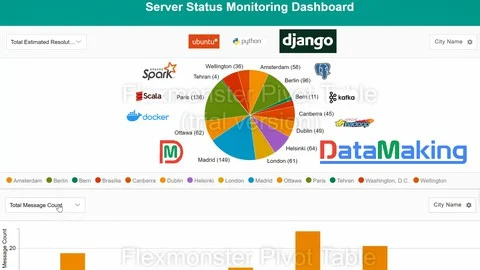
In today’s data centers, various types of servers constantly generate vast volumes of real-time event data—each event representing the server’s status. To ensure stability and minimize downtime, monitoring teams need instant insights into this data to detect and resolve issues swiftly.
To meet this demand, a scalable and efficient real-time data pipeline architecture is essential. Here’s how we’re building it:
🧩 Tech Stack Overview: Apache Kafka acts as the real-time data ingestion layer, handling high-throughput event streams with minimal latency.
Apache Spark (Scala + PySpark), running on a Hadoop cluster (via Docker), performs large-scale, fault-tolerant data processing and analytics.
Hadoop enables distributed storage and computation, forming the backbone of our big data processing layer.
PostgreSQL stores the processed insights for long-term use and querying.
Django serves as the web framework, enabling dynamic dashboards and APIs.
Flexmonster powers data visualization, delivering real-time, interactive insights to monitoring teams.
🔍 Why This Stack? Scalability: Each tool is designed to handle massive data volumes.
Real-time processing: Kafka + Spark combo ensures minimal lag in generating insights.
Interactivity: Flexmonster with Django provides a user-friendly, interactive frontend.
Containerized: Docker simplifies deployment and management.
This architecture empowers data center teams to monitor server statuses live, quickly detect anomalies, and improve infrastructure reliability.
Stay tuned for detailed implementation guides and performance benchmarks!
0 notes
Text
Best Courses to Stay Ahead in a Shifting Job Market
The world of work is changing fast — automation, AI, and remote-first workplaces are redefining career success. To stay relevant, you need more than just experience — you need future-proof skills that thrive despite technological disruption or economic slowdown.

✅ What Are Future-Proof Skills? These are high-impact, transferable skills that remain valuable across industries and adapt with evolving trends. Think:
Adaptability & Creativity
Digital Fluency
Data Literacy
Problem-Solving
In-demand areas include:
AI & Machine Learning
Cybersecurity
Digital Marketing
Healthcare & Telemedicine
UX/UI Design
Cloud Computing
Soft Skills (Leadership, Communication)
📚 Best Future-Proof Courses for 2025 Statistics & Data Science with R → Master analytics & decision-making. Great for: Analysts, researchers, career switchers.
Ultimate IT Support Course → Foundational tech support & cybersecurity. Great for: Tech beginners & career changers.
Generative AI for All: Prompt Engineering → Unlock AI tools like ChatGPT for productivity. Great for: Marketers, writers, educators.
Complete Digital Marketing Guide (27-in-1) → Learn SEO, ads, content, and email marketing. Great for: Freelancers, business owners, marketers.
Mastering A/B Testing in UX Design → Optimize user experience with data. Great for: Designers, product managers, strategists.
Communication Skills 101 → Public speaking, writing, teamwork & leadership. Great for: Managers, client-facing pros, team leads.
🎯 Choosing the Right Course Match skills to your career path or transition goal
Compare duration, ROI, real-world projects, and credibility
Prefer university-backed or employer-recognized certifications
Read reviews and job placement outcomes
💡 Bonus: Recession-Proof Career Tips Diversify Your Skillset – Add complementary skills like analytics, design, or communication.
Start a Side Hustle – Monetize your talent on Upwork, Fiverr, or LinkedIn.
Network Digitally – Join online communities and industry groups.
Stay Updated – Follow newsletters, attend webinars, and learn continuously.
Your Takeaway: The job market belongs to the agile, skilled, and visible. Equip yourself with future-proof skills, pick the right courses, and stay connected — and you won’t just survive 2025, you’ll thrive in it.
0 notes
Text
Best Online Courses for Building a Personal Brand
In 2025, personal branding isn’t optional — it’s essential. Whether you’re a freelancer, coach, creative, or corporate professional, your digital identity is now your reputation, resume, and income stream all in one. With remote work, side hustles, and the booming creator economy, building a trustworthy and profitable personal brand online is a game-changer.
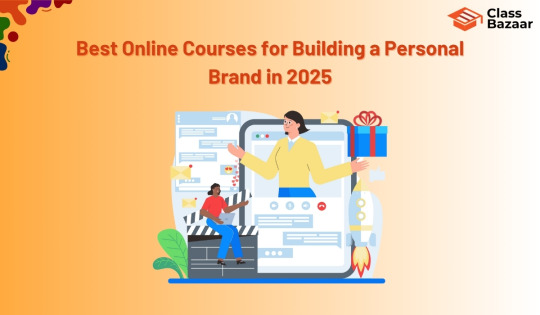
Your online presence — from your LinkedIn profile to your Instagram posts — speaks louder than your CV. That’s why mastering personal branding can help you gain visibility, attract clients, and build new revenue streams.
What Makes a Personal Branding Course Worth It? A strong course should cover:
Identity & Positioning – Crafting your story and brand voice.
Platform Strategies – Using LinkedIn, Instagram, or YouTube effectively.
Practical Tools – Templates, exercises, and actionable steps.
Mentorship or Community – Learning with others and getting feedback.
Here are some top-rated personal branding courses in 2025:
🔹 Build Your Personal Brand in 4 Easy Steps (Udemy) Perfect for beginners looking to take their first steps into online branding.
🔹 Personal Branding Masterclass (Udemy) A complete toolkit covering storytelling, social growth, and online reputation.
🔹 AI Powered Personal Branding on Social Media (Udemy) Leverage AI tools for faster content creation and better reach.
🔹 Deliver a Clear Elevator Pitch (Udemy) Short and focused – ideal for job seekers and consultants.
🔹 Become THE Go-To Person (Udemy) Position yourself as an expert and trusted voice in your niche.
In short, with the right course and consistent effort, you can turn your online presence into influence, trust, and income.
0 notes
Text
Microlearning: The Future of Online Education in 2025
Microlearning in 2025: The Future of Fast, Flexible Education In a fast-paced world like 2025, long lectures and full-day classes don’t quite fit into busy schedules. That’s why microlearning—a method of delivering short, focused learning content—is gaining massive popularity across industries and age groups.
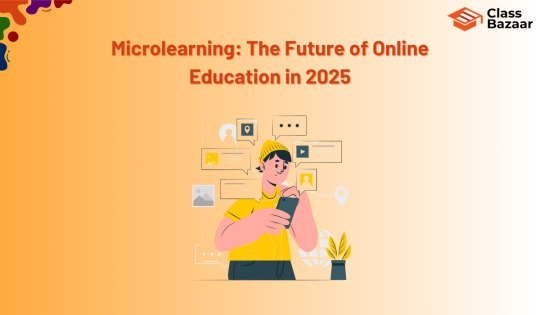
Whether you’re a student preparing for exams or a professional aiming to upskill, microlearning delivers exactly what you need in just 2–10 minutes per session.
What is Microlearning? Microlearning breaks complex topics into bite-sized lessons that are easy to digest and remember. Unlike traditional e-learning, which can involve lengthy modules and heavy reading, microlearning offers mobile-friendly, engaging content—think flashcards, quizzes, infographics, and short videos.
These modules fit into your daily life, allowing you to learn while commuting, taking a coffee break, or even in between meetings. It’s designed to match the brain’s natural ability to process information in chunks, making learning both effective and convenient.
Why Microlearning Works 🔹 Higher Retention & Engagement Microlearning uses key principles of cognitive science—like spaced repetition and micro-assessments—to make learning stick. Because the content is short and specific, learners stay engaged and are more likely to complete modules.
🔹 Anytime, Anywhere Learning Thanks to mobile-first design, learners can study on the go. Whether you have 5 minutes or 15, there’s always time to learn something new—perfect for multitaskers and those with packed schedules.
🔹 Cost-Effective & Time-Saving Most micro-courses are free or low-cost, making high-quality education accessible. You don’t need to commit hours or spend heavily—10 minutes a day can gradually build new skills or strengthen old ones.
Top Microlearning Platforms in 2025 Class Bazaar Aggregates the best micro-courses across the internet. Perfect for learning coding, design, or business skills with helpful filters for time, level, and price.
LinkedIn Learning Offers thousands of skill-focused clips for professionals. Courses are optimized for business use and include certifications that can be added to your LinkedIn profile.
Udemy Known for its wide range of short and affordable courses in tech, health, marketing, and more.
Duolingo Popular for language learning through gamified lessons. Its 5–10-minute daily quizzes and AI-driven conversations keep users engaged.
Coursera & edX Offer “MicroMasters” and “MicroBachelors” programs—short, stackable courses that lead to recognized certifications.
Must-Try Microlearning Courses Easy Python Programming – Ideal for beginners to get a hands-on start in coding.
Ignite Your Soft Skills – Improve communication and time management in quick bursts.
Microsoft Excel Essentials – From basic to advanced Excel skills, plus a certificate.
AI for Leaders – Helps business professionals grasp AI concepts without a tech background.
Who Should Use Microlearning? Students – Prepare for tests and grasp difficult topics quickly.
Professionals – Learn new tools or strategies during commutes or work breaks.
Freelancers – Balance multiple gigs while gaining skills one module at a time.
Companies – Train employees effectively with budget-friendly, on-demand content.
How to Get the Most from Microlearning Set Daily or Weekly Goals – Even one module a day adds up fast.
Use Mobile Apps – Duolingo, Class Bazaar, and LinkedIn Learning make learning portable.
Track Progress – Use apps like Notion to monitor streaks, completion, and time spent.
Apply What You Learn – Reinforce knowledge through real-life tasks.
Use Spaced Repetition – Tools like Anki help with long-term memory retention.
The Future of Microlearning in EdTech 2025 is seeing exciting innovations that will reshape how we learn:
AI-Personalized Paths – Adaptive learning based on user activity and goals.
Customized Experiences – Content tailored to your learning style (visual, audio, interactive).
Wearables & Smart Assistants – Get lessons on your smartwatch or voice assistant.
Gamification – Streaks, leaderboards, and instant feedback make learning addictive and fun.
Final Thoughts Microlearning is no longer just a trend—it’s becoming the backbone of modern education. It’s flexible, effective, and perfect for the fast-moving world of 2025. Whether you're leveling up your career, studying for exams, or picking up a new hobby, microlearning makes learning easier, faster, and more fun.
0 notes
Text
EmpowerEd: How Technology Helps English Language Learners Thrive
In today’s increasingly multilingual classrooms, English Language Learners (ELLs) face a dual challenge—mastering academic material while navigating the complexities of a second or third language. As both a teacher and educator, I’ve seen how technology can be a game-changer for these students.

Contrary to common fears, digital tools like smartphones, laptops, and translation apps aren’t just distractions—they’re essential resources. In my experience with three Grade 11 ELL students, these tools helped bridge language gaps, define key vocabulary, and keep up with lessons in real-time. With access to platforms like Google Classroom and translation apps, students felt more confident, engaged, and independent.
But it's not about replacing traditional learning. These students valued handwritten notes, visual aids, and classroom board work just as much. They preferred a balanced approach—one that thoughtfully blends technology with classic methods. They used tech not to escape the classroom, but to connect with it more deeply.
Importantly, the teacher’s role remains central. When educators share materials in advance and create space for flexible, responsible tech use, students thrive. Instead of banning phones outright, we should teach mindful, purposeful use. For many ELLs, a smartphone isn’t a distraction—it’s a vital support system.
In the end, technology won’t magically erase the challenges ELLs face, but when used wisely, it opens doors. It’s not about prohibition—it’s about empowerment.
0 notes
Text
EmpowerEd: How Technology Helps English Language Learners Thrive
In today’s multilingual classrooms, English Language Learners (ELLs) face dual challenges—mastering academic content while overcoming language barriers. As both a teacher and educator, I’ve seen firsthand how digital technology can act as a powerful support system, enabling ELLs to thrive with greater confidence and independence.

Technology as a Learning Lifeline My experience with three Grade 11 ELL students revealed that digital tools—smartphones, laptops, and translation apps—were not distractions but essential aids. These tools helped students look up unfamiliar vocabulary, revisit class notes via photos, and stay connected through platforms like Google Classroom. Far from passive consumption, this was active learning—driven by need and enabled by technology.
The Power of Blending Digital with Traditional Interestingly, these students didn’t depend solely on tech. They valued traditional methods too—brainstorming on paper, whiteboard instruction, and handwritten notes. Many began with ideas in their first language, then transferred them into English using digital tools. This balance helped with memory, comprehension, and comfort.
The takeaway? ELLs benefit from a thoughtful mix of digital tools and conventional strategies. Slides, when paired with time for reflection, and videos, when previewed in advance, were especially effective. Tech worked best when it supported—not replaced—human-centered teaching.
Teachers Make the Difference One standout insight was the importance of teachers in guiding technology use. Students felt empowered when teachers shared class materials early, used tech intentionally, and gave them autonomy in deciding when and how to use their devices. Trust, not restriction, nurtured engagement.
Rethinking Device Bans Many schools lean toward banning phones to curb distractions. But for ELLs, phones often serve as vital tools for translation, clarification, and access to resources. A blanket ban risks cutting off their primary learning aid.
Rather than prohibit, we should educate—on responsible use, purposeful application, and balance. School policies must reflect the diverse needs of learners, not punish those who depend on tech the most.
Conclusion: A Device with a Purpose Technology isn’t a cure-all—but when used wisely, it bridges gaps and builds confidence. For ELLs, that familiar device in their pocket could be the key to deeper understanding, better participation, and educational ownership. Our goal shouldn’t be to ban it—but to teach students how to use it meaningfully.
Let’s meet students where they are, and help them move forward—one thoughtful click at a time.
0 notes
Text
Top Tips to Use Online Courses for Govt. Exam Prep
How Online Courses Are Changing Government Exam Prep in India (2025)

Over the past few years, especially post-pandemic, online coaching has transformed how students prepare for competitive exams like UPSC, SSC, Banking, and State PSCs. No longer restricted to Delhi or big cities, top-tier coaching is now available online—accessible, affordable, and flexible.
Platforms like Unacademy, BYJU’S Exam Prep, Adda247, Drishti IAS, and Testbook offer everything from live classes, recorded videos, doubt sessions, to full mock test series. Whether you're a college student or a working professional, these tools allow you to study anytime, anywhere—without hefty coaching fees or relocation.
Why Online Learning Works: Flexible for Busy Schedules: Recorded and live sessions let you study at your pace.
Budget-Friendly: Free and affordable courses remove financial barriers.
Expert Mentorship: Learn from top educators across India with focused strategies and study plans.
Exam-Specific Content: Tailored courses for UPSC, SSC CGL, IBPS, SBI PO, BPSC, and more in multiple languages.
Test-Ready Tools: Weekly mocks, quizzes, and smart analytics help track progress and improve.
Key Platforms to Explore: Unacademy – Live batches, doubt-solving, and expert strategies for UPSC to SSC.
BYJU’S Exam Prep – Recorded & live courses for SSC and banking aspirants.
Adda247 – Bilingual content, quizzes, and prep for Tier 2/3 city students.
Drishti IAS – Ideal for Hindi-medium UPSC aspirants.
Testbook – Strong mock test series and affordable plans.
Smart Tips for Online Exam Prep: Set a fixed routine and follow a structured syllabus.
Avoid hoarding multiple courses—stick to 1-2 platforms.
Take mock tests weekly to track your growth.
Balance static topics with current affairs.
Don’t just watch—take notes and revise consistently.
Final Words In 2025, online coaching has become the most efficient and inclusive way to prepare for government exams. All you need is discipline, the right course, and a clear study plan. Platforms like Class Bazaar help simplify your search by offering verified courses for every major exam. Start your smart exam prep today—from your home, at your time.
0 notes
Text
How Online Courses Maximize Learning Retention
Why Learning Retention Matters in Online Education: A Smarter Way to Learn
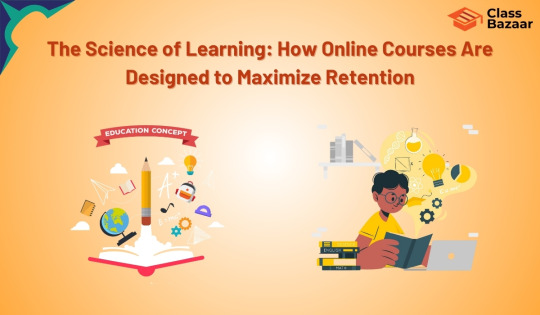
In the world of online education, access is no longer the problem—retention is. Millions of learners sign up for online courses, yet only 5–15% finish them (Class Central, 2024). But even completion isn't the real goal—it's about how much of that knowledge sticks and can be applied in real-life work.
The smartest platforms today understand this. They use cognitive learning science to build courses that do more than deliver information—they help you retain it. That means shorter videos, hands-on tasks, spaced repetition, and real-world projects. This isn't just for students—professionals benefit too, as workplace demands continue to rise.
Key methods that enhance retention include:
Cognitive Load Management: Simple interfaces and step-by-step content reduce mental overload.
Spaced Repetition: Reviewing material over time boosts long-term memory.
Active Recall & Interleaving: Quizzes and mixing topics improve learning connections.
Microlearning: Short, focused lessons keep attention high and retention strong.
Top platforms like Coursera, edX, Google, and Udemy build these methods into their course design. Features like peer forums, projects, feedback loops, and progress tracking keep learners engaged and motivated.
When choosing a course, look for:
Interactive elements like quizzes and discussions
Positive reviews highlighting clarity and engagement
Clear objectives and practical projects
Platforms that use learning science (e.g., Coursera, edX, FutureLearn)
In short, learning smarter is more effective than learning harder. Courses that are well-structured, interactive, and based on neuroscience principles help you remember and apply what you learn. At Class Bazaar, we curate exactly those kinds of courses—so your learning really sticks.
0 notes
Text
Best AI Courses for Beginners & Non-Tech Roles
AI Upskilling for Non-Tech Professionals: Why 2025 Is the Time to Start
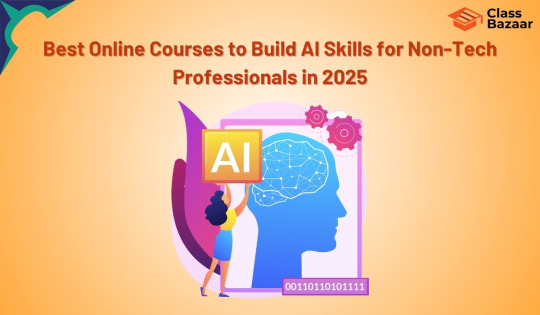
Artificial Intelligence is no longer a buzzword—it’s a workplace essential. Once confined to engineering and data science, AI now plays a big role in marketing, HR, education, and management. Whether you're drafting emails, screening resumes, or building lesson plans, AI tools like ChatGPT, Canva AI, and Jasper are already transforming how we work.
But here’s the good news: you don’t need to know how to code to use AI effectively. You just need to know how to work with it.
Why You Should Learn AI Now By 2025, over 50% of companies expect AI to be embedded into most business operations (McKinsey). This shift isn’t about replacing people but empowering them to work smarter, make data-driven decisions, and boost creativity.
Whether you’re in HR, marketing, teaching, or leading a team—basic AI skills like prompt engineering, ethical AI awareness, and decision-making with AI insights are becoming critical.
Must-Have AI Skills (No Coding Needed) AI & ML Basics: Understand the "what" and "why" without math or code.
Hands-On Tools: Work with ChatGPT, Midjourney, and Canva AI to boost productivity and creativity.
Prompt Engineering: Learn how to talk to AI tools effectively for better outputs.
AI Ethics: Get familiar with concepts like data privacy and bias.
Strategic Thinking: Interpret AI insights to make better business decisions.
Best AI Courses for Beginners (No Tech Background Required) AI for Everyone by Andrew Ng (Coursera) – A must for understanding AI’s big picture.
ChatGPT Prompt Engineering for Beginners (Udemy) – Learn how to write better prompts for real-life use.
AI for Non-Technical Professionals (Columbia University) – Covers AI’s impact across industries.
AI in Business Strategy (Coursera) – Designed for managers and consultants.
Google Generative AI Courses – Short, focused lessons on prompt writing, AI safety, and more.
How to Choose the Right AI Course Pick a course based on:
Time available – Quick wins or deep dives?
Platform reputation – Coursera and edX offer academic structure; Udemy is great for hands-on skills.
Balance of theory and practice – Choose practical, project-based content.
Community access – Look for discussion forums and mentorship options.
Pro Tip: Opt for courses that help you use real AI tools like ChatGPT, Notion AI, or Synthesia in your day-to-day work.
Real Stories, Real Impact Priya (Digital Marketer) now creates ad content twice as fast using ChatGPT.
Jacob (Teacher) builds interactive lesson plans with Canva AI.
Ananya (HR Executive) uses AI tools to screen candidates and write inclusive job descriptions—no coding needed.
Final Thoughts: Start Your AI Journey Today AI is becoming the new digital literacy. You don’t need a tech degree—just the right mindset and tools. Begin with a simple course, explore how AI applies to your role, and grow from there.
🧠 Start learning now and future-proof your career. Explore beginner-friendly AI courses on Class Bazaar and take the first step toward becoming AI-smart in 2025.
0 notes
Text
Learning Analytics: The Secret to Thriving in EdTech
Why Learning Analytics is Essential in EdTech Today

Learning analytics involves collecting, measuring, analyzing, and reporting data on learners to improve both educational outcomes and the environments where learning takes place. With the rise of online learning and cloud-based LMS platforms, educational institutions and EdTech companies now collect more student data than ever—data that instructional designers and other professionals use to:
Personalize learning experiences
Predict and prevent student dropouts
Improve teaching strategies and content
According to IMARC, Globe Newswire, and market.us, the global EdTech market is projected to exceed $700 billion by 2033, largely driven by data-driven personalization and analytics.
Where Learning Analytics Fits in EdTech
Professionals across EdTech roles now rely on learning analytics—not just back-end teams. Whether you're in curriculum design, platform development, research, or product building, understanding data is becoming essential.
Instructional Designers use LMS data and dashboards to identify where students struggle and optimize learning paths.
LMS & Product Managers analyze student interactions to enhance features and user experience.
Educators & Academic Researchers use data to track student progress, refine teaching methods, and guide policy decisions.
EdTech Analysts help startups improve product design and learner engagement by monitoring user data.
Tip: If you're in education or tech, learning analytics is a natural next step to grow your impact.
Key Skills to Master in Learning Analytics
To thrive in this field, you need a mix of educational, analytical, and technical skills:
Data Literacy – Understand statistics, visualize data using Excel, Google Sheets, or BI tools.
LMS Proficiency – Navigate platforms like Moodle, Canvas, or Blackboard for data analysis.
Python/R (Optional) – Use these tools for advanced data modeling and automation.
Pedagogy Knowledge – Understand how people learn to make data meaningful.
Tools to Know – Tableau, Power BI, xAPI, and SCORM help you collect and interpret learner data effectively.
Top Online Courses to Get Started
Explore these beginner-friendly, highly-rated courses:
Learning Analytics Fundamentals (edX) – Covers core concepts and real-world applications.
Analytics in Course Design (Coursera) – Helps teachers and designers use data for better engagement.
Instructional Design and Technology (Coursera) – Combines teaching strategies with data use.
Excel to MySQL (Coursera) – Teaches key analytics tools like SQL, Tableau, and Excel.
Data Science for Education – A curated list for educators and administrators looking to grow data skills.
You can find many of these courses on Class Bazaar.
Careers & Salaries in Learning Analytics
As educational choices become increasingly data-driven, EdTech offers diverse career opportunities:
Instructional Data Analyst ($60K–90K) – Helps course creators use LMS data to enhance learning.
Learning Consultant ($70K–100K) – Works with schools or companies to implement data-backed learning strategies.
Academic Researcher – Studies digital learning methods and student behavior, often grant-funded.
Product Analyst (EdTech SaaS) – Uses data to guide product development and improve user experiences.
Where You Can Work: Top EdTech companies (like Coursera, Byju’s, and Khan Academy), universities, and government-led digital learning initiatives are all hiring for analytics roles.
Case Study: Real-World Impact
At Georgia State University, tracking over 800 student data points helped identify at-risk students early and raised graduation rates by over 20% in ten years. Similarly, K–12 schools use dashboards to boost engagement and reduce absenteeism, while platforms like edX and Coursera use predictive analytics to improve course completion.
Final Thoughts
Learning analytics sits at the intersection of education, technology, and social impact. As data increasingly shapes how we teach and learn, those with the right skills will be in high demand. Whether you're an educator, technologist, or career switcher, this field offers purpose, impact, and growth.
Don’t miss out—start exploring Learning Analytics courses on Class Bazaar today.
0 notes
Text
Career Change with Online Learning – Myth or Reality?
The Rise of Career Switching in the Digital Age

Wondering if online learning can help you switch careers? You're not alone. More people than ever are pivoting professionally, driven by economic shifts, remote work, and the desire for meaningful or stable jobs. Hobbies and personal skills are becoming new career paths.
Online Learning: A New Path to Professional Growth
With platforms like Coursera, edX, and Udemy offering flexible, affordable education, switching careers is more accessible. Many learners balance jobs while earning certificates from top companies like Google, Meta, and IBM—credentials that are increasingly valued by employers.
In fact, LinkedIn reported that 43% of professionals in a recent survey used online tools to change their careers.
Top Skills You Can Learn Online
Whether you’re leaving finance, teaching, or homemaking, online courses can help you build practical, in-demand skills:
Data Science & Analytics: Learn Python, SQL, Tableau. Try courses like Google Data Analytics or IBM Data Science.
Digital Marketing: Master SEO, Google Ads, and social media. Certifications from Google and Meta are popular.
UX/UI Design: Study Figma, research methods, and portfolio building. Try Google’s UX Design Certificate.
Web Development: Start with HTML, CSS, and JavaScript. Courses like The Web Developer Bootcamp are ideal.
Essential Soft Skills You Can Build Online
Employers value more than just technical ability:
Communication: Improve writing and speaking skills. Explore LinkedIn Learning or university-led video courses.
Leadership: Learn team management, budgeting, and agile practices. Google’s Project Management Certificate is a solid choice.
Project Management: Courses like University of Michigan’s “Leading People and Teams” help build critical thinking and planning skills.
Real Success Stories
Priya (Sales to Data Analyst): Completed Google Data Analytics in 6 months, built a portfolio, and landed a new role.
Rohan (Teacher to UX Designer): Switched careers after completing Google’s UX Design course and freelancing.
Anita (Homemaker to Developer): Joined Udemy’s Web Developer Bootcamp, built apps, and now works in tech.
How Employers View Online Certificates in 2025
Skills now outweigh degrees. Recruiters value hands-on experience, flexibility, and project portfolios. Courses from respected platforms—Coursera, edX, Udemy—are widely recognized, especially those backed by brands like Google or IBM.
What Employers Look For
Portfolio over paper: Code on GitHub, designs on Behance, and marketing dashboards all matter.
Project-based proof: Applied knowledge is key—employers love to see real results.
How to Make Online Learning Work
Define Your Target Role: Know the job and its skill requirements before starting.
Choose Respected Courses: Opt for programs backed by industry leaders or universities.
Build a Portfolio: Projects prove your skills—upload and organize them well.
Join Online Communities: Use LinkedIn, Discord, or forums to grow and get feedback.
Start Freelancing or Interning: Practical experience, even volunteer-based, strengthens your resume.
Debunking Common Myths
Myth: You need a degree to get a job → Reality: Skills and results matter more now.
Myth: Online learning isn't credible → Reality: Top institutions now teach online.
Myth: It’s too late to switch → Reality: Many people in their 30s–50s are doing it.
Final Thoughts: Can Online Learning Truly Help You Switch Careers?
Absolutely—if you follow a plan. Online courses alone aren’t magic, but paired with practical projects, community involvement, and persistence, they’re powerful. Whether you're eyeing tech, design, marketing, or management, online education can launch your next career—without quitting your job or going into debt.
Start your journey today. Find the right course and make your switch!
0 notes
Text
ADVANCED Accredited Crystal Healing Practitioner Course
🔮 Unlock Ancient Wisdom with the Advanced Certified Crystal Healing Practitioner Course

Are you ready to deepen your connection with the powerful energy of crystals? If you’ve already completed the Certified Crystal Healing Practitioner Course, it’s time to take your spiritual journey to the next level with the Advanced Certified Crystal Healing Practitioner Course.
In this advanced course, we return to the mystical era of Atlantis, tapping into ancient wisdom where crystals were used for communication, manifestation, healing, and even transportation. If you’re feeling drawn to this path, it may be your soul’s way of reconnecting with a past life—perhaps when you once worked with these very tools of light and energy.
✨ What to Expect:
Reconnect with the 13 Crystal Skulls of Atlantis through an advanced Cosmic Grid technique
Work closely with crystal energies, including the renowned Mitchell-Hedges skull
Receive and practice 8 guided meditations to activate deeper healing and intuition
Expand your personal collection—because, truly, you can never have enough crystals!
This course isn’t just about learning—it’s a spiritual awakening, a call to rediscover the knowledge encoded in your soul. Throughout the journey, you’ll be supported, guided, and encouraged to embrace your inner crystal healer.
💎 Ready to amplify your crystal practice and awaken ancient memories? Join the course and step into your advanced healing power!
0 notes
Text
Power BI - The Complete Course
🔍 Master Data Analysis with This End-to-End Power BI Course
Whether you're just starting out or aiming to upskill, our Power BI Data Analysis Course is designed to take you from beginner to intermediate level with confidence. This hands-on course enables you to independently carry out real-world data analysis using Power BI.

💡 What You’ll Learn:
Throughout the course, you’ll learn how to extract data from multiple sources like Excel, web data, and SQL Server. You’ll also get in-depth training on how to clean, transform, and model data to uncover insights.
From building interactive dashboards to using DAX functions for calculations, this course provides a comprehensive approach. You’ll even discover how to leverage AI insights for trend detection and anomaly spotting.
🛠️ Key Topics Covered:
Power BI Installation & Setup
Importing & Transforming Data
Connecting to SQL Server & Web Data
Data Modeling & Relationships
Calculated Columns & Quick Measures
Visualizing Data with Charts & Filters
Publishing Reports to Power BI Service
Deep Dive into DAX Functions
🎯 Learning Outcomes: By the end of this course, you will:
Understand Power BI's core features and business value
Clean and prepare data for analysis
Build professional dashboards and reports
Use AI-powered tools to derive smart insights
Navigate and share dashboards using Power BI Service
All practice datasets are provided so you can apply what you learn and build your portfolio. Perfect for aspiring data analysts, this course helps you turn raw data into powerful business decisions.
Ready to transform your data skills? Start learning Power BI today!
0 notes
Text
Linux Kernel Development Course
Ever wanted to dive into the world of Linux kernel development and create your own kernel modules? This beginner-friendly course by Daniel McCarthy, an experienced Linux kernel developer, is your perfect starting point.

Taught by an Industry Expert Daniel has held senior roles developing third-party kernel drivers for private companies. Drawing from his professional experience, he brings real-world insights and best practices to every lesson.
What You'll Learn This step-by-step course guides you through:
Setting up your development environment with all the necessary dependencies.
Creating your first Linux kernel module — a simple "Hello World" that runs from kernel space.
Building a character device module, similar to /dev/random, allowing user-space programs to interact with kernel-space.
What Makes This Course Unique? When Daniel was learning kernel development, he struggled with outdated resources. This course is built to fix that — it uses up-to-date techniques and teaches a unique trick that simplifies the entire learning process.
Everything Explained, Nothing Skipped The course goes in-depth, explaining every detail of what you're doing. No more guesswork or piecing together tutorials from outdated forums.
Conclusion: Whether you're just starting out or looking to explore kernel space programming, this course demystifies Linux kernel development and gets you hands-on with real modules. Learn from a professional and start writing kernel code the right way.
0 notes
Text
Data Structures and Algorithms Complete Course - CPP & JAVA
Looking to boost your coding skills and crack technical interviews? The Complete Data Structures and Algorithms Course using C++ & Java by GeeksforGeeks is the perfect place to start.

Why This Course? This course is designed to help learners understand how to efficiently organize and manipulate data, solve real-world problems, and improve problem-solving skills using two of the most widely used programming languages: C++ and Java.
Who Is It For? Whether you're a beginner aiming to grasp the basics or an experienced coder looking to master advanced concepts, this course caters to all skill levels.
What You'll Learn: Core concepts of Data Structures such as Arrays, Linked Lists, Stacks, and Queues
Advanced topics like Trees, Graphs, Hashing, and Dynamic Programming
Hands-on coding in both C++ and Java
Problem-solving techniques for coding interviews and competitive programming
Why C++ and Java? These languages are industry favorites for DSA due to their speed, structure, and community support. Learning both offers a strong foundation for any developer.
Conclusion: This DSA course is not just a learning opportunity — it’s a step toward becoming a more efficient and confident coder. Ready to level up? Start your journey with GeeksforGeeks today.
0 notes
Text
Cyber Security Courses: Guide to Protecting Digital Assets
The Growing Significance of Cyber Security
In today’s digital world, the importance of cyber security is more critical than ever. As technology and the internet have become essential tools for individuals and businesses alike, they’ve also opened the door to numerous cyber threats. These threats can result in data breaches, malware infections, identity theft, financial losses, and more.
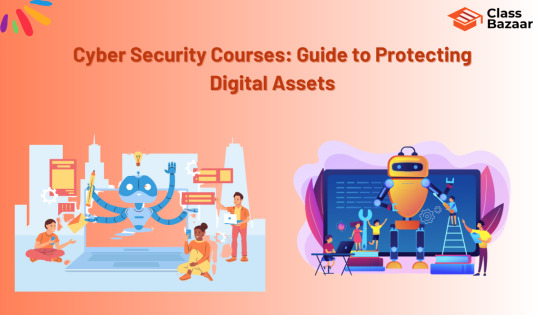
To counter these risks, understanding and addressing cyber threats has become vital for safeguarding digital assets. This is where Class Bazaar’s cyber security courses come into play. They provide essential knowledge to help secure systems, devices, programs, and data from unauthorized access and malicious attacks.
Why Cyber Security Matters
With the rapid advancement of information technology and internet usage, the world has experienced both immense benefits and increasing cyber vulnerabilities. From critical infrastructure to personal data, nothing is immune from cybercriminals. Businesses and individuals have already suffered significant losses due to hacking incidents and data leaks.
Cyber attacks are no longer just financially motivated. They can lead to breaches of customer data, theft of intellectual property, and compromise of business-critical information. Whether you're an everyday internet user or responsible for safeguarding an organization’s IT infrastructure, adopting a proactive approach to cyber security is crucial.
What You’ll Learn in Cyber Security Courses
Cyber security courses offer both theoretical and hands-on training. Students learn to secure hardware and software, recognize and respond to threats, manage data recovery, and build resilience against attacks.
Key Areas Covered:
Network Security: Protecting systems and networks from unauthorized access
Cloud Security: Securing data stored in cloud environments
Application Security: Ensuring software remains safe from threats
Information Security: Preserving data integrity and confidentiality
Operational Security: Managing risks and everyday security protocols
Disaster Recovery & Business Continuity: Preparing for and recovering from incidents
Cryptography: Encrypting information to prevent unauthorized access
Cyber Law & Policy: Understanding digital regulations and standards
Cyber Forensics: Investigating and analyzing cyber incidents
Courses may also include modules on threat detection, penetration testing, ethical hacking, malware analysis, and more.
Benefits of Cyber Security Training
Develop High-Demand Skills: Cyber security professionals are in short supply, increasing job and business prospects.
Prevent Data Breaches: Proactive protection reduces the risk of cyber attacks.
Lower Insurance Premiums: Trained employees can help reduce cyber insurance costs.
Meet Compliance Requirements: Many regulations require formal security training.
Increase Employability: Certifications enhance job prospects in tech, telecom, and IT industries.
Improve Personal Security: Learn how to keep your own data and online transactions safe.
Conclusion
Cyber security is no longer just an IT concern—it’s a strategic priority for everyone. Whether you're planning a career in digital security or managing sensitive business information, investing in a quality training program, such as those offered by Class Bazaar, is a smart move. Their comprehensive courses equip learners with the skills to handle modern cyber challenges confidently and competently.
0 notes
Text
Réseaux sociaux en digital marketing: la MasterClass unique
Dans un monde où le digital évolue à grande vitesse, se former aux réseaux sociaux et au community management n’est plus une option, mais une nécessité. Que vous soyez entrepreneur, professionnel du marketing ou community manager débutant, cette MasterClass unique et complète vous offre les clés pour comprendre et exploiter pleinement le potentiel des plateformes sociales.

Avec la montée en puissance du marketing digital, les entreprises doivent repenser leur manière de communiquer, d’interagir avec leur public, et surtout, de vendre. Cette formation vous guide pas à pas à travers les stratégies modernes de gestion de communauté, les bonnes pratiques de publication, et les outils indispensables pour performer en ligne.
Rejoignez cette MasterClass pour transformer vos connaissances en expertise et faire des réseaux sociaux un véritable levier de croissance pour votre activité.
0 notes